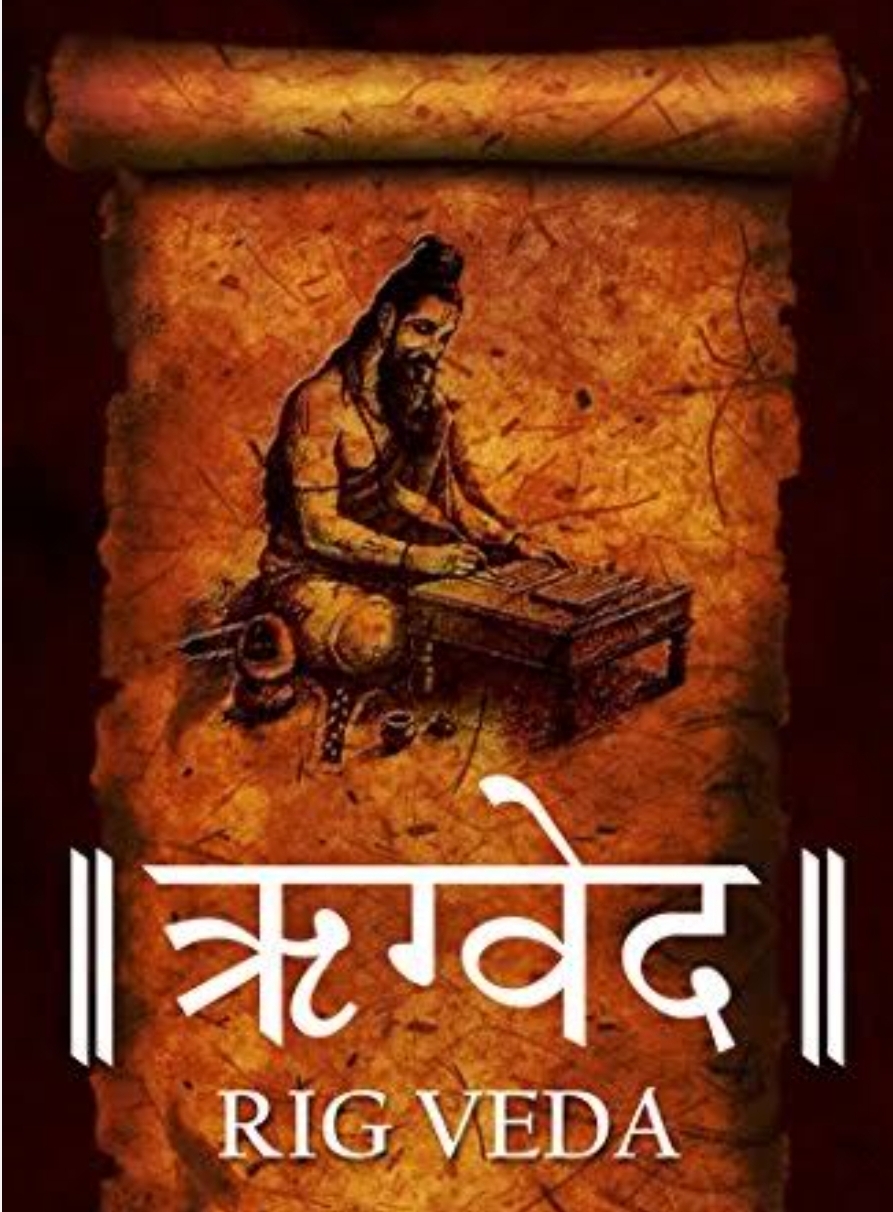Rigveda Samhita, The Timeless Jewel Within The Treasure Trove Of The 4 Vedas
Rigveda Samhita is the oldest and most revered of the four Vedas in Hinduism. It consists of a collection of hymns, mantras, and prayers composed in the Sanskrit language. Here are some key points about the Rigveda Samhita:
1. Age and Significance : The Rigveda Samhita is the oldest of the four Vedas and is believed to have been composed between 1500 and 1200 BCE during the early Vedic period.It holds immense significance in Hinduism as the foundational text for religious and philosophical thought.
2. Number of Hymns: The Rigveda Samhita comprises 1,028 hymns (suktas) spread across ten books known as “Mandalas.” Each Mandala is further divided into hymns dedicated to specific deities or natural forces.
The number of hymns in each of the ten Mandalas (books) of the Rigveda Samhita are:
Mandala 1: This Mandala contains 191 hymns.
Mandala 2: It consists of 43 hymns.
Mandala 3: This Mandala has 62 hymns.
Mandala 4: It contains 58 hymns.
Mandala 5: This Mandala consists of 87 hymns.
Mandala 6: It contains 75 hymns.
Mandala 7: This Mandala has 104 hymns.
Mandala 8: It consists of 103 hymns.
Mandala 9: This Mandala contains 114 hymns.
Mandala 10: It has the highest number of hymns, totaling 191.
3. Deities and Themes: The Rigveda contains a wide range of themes and addresses various deities and natural forces. Here are some of the prominent themes and deities found in the Rigveda:
1. Agni (Fire):
– Agni, the god of fire, is one of the most frequently mentioned deities in the Rigveda.
– Hymns dedicated to Agni often seek his blessings for the success of rituals and sacrifices.
– Agni is seen as the intermediary between humans and the other gods, carrying offerings to the divine realm.
2. Indra (Rain and Thunder):
– Indra, the god of rain, thunder, and lightning, is a central figure in the Rigveda.
– Many hymns celebrate Indra’s heroic feats, such as defeating cosmic demons (asuras) and releasing the waters.
– He is praised for his role in providing rain and ensuring the fertility of the land.
3. Varuna (Cosmic Order):
– Varuna is revered as the god of cosmic order, moral law, and righteousness.
– Hymns dedicated to Varuna often explore concepts of divine justice, truth, and the consequences of immoral actions.
4. Ushas (Dawn):
– Ushas, the goddess of dawn, is celebrated in hymns that depict the beauty and symbolic significance of the dawn’s arrival.
– She is seen as the bringer of light, dispelling darkness and symbolizing the renewal of the day.
5. Agni-Soma Ritual:
– Many hymns focus on the ritualistic use of Agni (fire) and Soma (a sacred plant) in Vedic ceremonies.
– The precise procedures for preparing and offering these substances are detailed in these hymns.
6. Creation and Cosmology:
– Some hymns explore cosmological themes, describing the creation of the universe and the interconnectedness of all beings.
– These hymns provide early philosophical insights into the nature of existence.
7. Nature and Elements:
– Various hymns pay homage to natural elements such as the wind (Vayu), the sun (Surya), and the earth (Prithvi).
– These hymns acknowledge the importance of these elements in sustaining life and the ecosystem.
8. Philosophical Inquiries:
– The Rigveda contains hymns that raise profound philosophical questions about the nature of the self (Atman), the ultimate reality (Brahman), and the meaning of life.
– These inquiries laid the groundwork for later developments in Hindu philosophy.
9. Sacrifices and Rituals:
– A significant portion of the Rigveda is dedicated to hymns that provide instructions for performing rituals and sacrifices.
– These hymns outline the proper procedures, mantras, and offerings to appease the gods.
4. Structure and Language: The Rigveda is known for its poetic and structured composition. It is written in a complex form of Sanskrit and is characterized by its use of meter and rhythm. The hymns are intended for recitation during religious rituals and ceremonies.
5. Cultural and Historical Insights: The Rigveda provides valuable cultural insights into the society and way of life in ancient India during the Vedic period. Here are some cultural aspects and insights that can be gleaned from the Rigveda:
1. Agrarian Society: The Rigveda reflects an agrarian society heavily dependent on agriculture and pastoralism. Many hymns mention cattle as a source of wealth, and there are hymns dedicated to cattle herding and the importance of cows in daily life.
2. Rituals and Sacrifices: The Rigveda contains detailed descriptions of various rituals and sacrifices performed by priests. These rituals were a central part of Vedic culture and were conducted to seek divine blessings, prosperity, and protection.
3. Social Structure: The hymns of the Rigveda allude to a hierarchical social structure. The priests, or Brahmins, played a crucial role in conducting rituals and interpreting the sacred texts. The hymns also mention kings (rajas) and warriors as prominent figures.
4.Sanskrit Language: The Rigveda is one of the earliest known texts written in the Sanskrit language. Its composition reflects the development of this ancient Indo-European language, which has had a profound impact on the linguistic and literary traditions of India.
5.Sacred Geography : The hymns in the Rigveda mention various rivers, mountains, and geographical features, which were often imbued with religious and mythological significance. The Sarasvati River, for example, is frequently mentioned and revered.
6. Religious Syncretism: The Rigveda shows signs of religious syncretism, where multiple deities from different traditions are mentioned. Over time, some of these deities would become more prominent in Hinduism.
7.Vedic Gods and Deities: The hymns provide insights into the early Vedic pantheon, with deities like Agni (fire), Indra (rain and thunder), Varuna (cosmic order), and Ushas (dawn) being celebrated. These deities played essential roles in the daily life and religious practices of the people.
8. Poetry and Oral Tradition: The Rigveda is written in a highly poetic and structured form, making it suitable for oral transmission. It reflects the importance of oral tradition in passing down religious knowledge, hymns, and rituals from one generation to the next.
9.Ethical and Moral Values: Some hymns touch upon ethical and moral values, emphasizing truth, righteousness, and honesty as virtuous qualities. These values were considered integral to leading a virtuous life.
10.Cosmological Ideas: The Rigveda contains hymns that offer cosmological insights, describing the creation of the universe, the celestial bodies, and the interconnectedness of all living beings.
11.Natural Phenomena: Hymns in the Rigveda often address natural phenomena like storms, rain, and the changing seasons. These observations of the natural world played a role in religious and agricultural practices.
12.Cultural Practices: The hymns also provide glimpses into cultural practices, including marriage ceremonies, funeral rites, and the preparation of food offerings for rituals.
6. Influence: The Rigveda has had a profound influence on Hinduism and continues to be a source of inspiration for Hindu religious thought, rituals, and philosophy. It has also influenced the development of other Indian religious and philosophical traditions.
7. Commentaries: Over the centuries, scholars have written extensive commentaries on the Rigveda to explain its verses, rituals, and philosophical concepts. These commentaries have helped preserve and interpret the text.
The Rigveda Samhita is not just a religious text but also a cultural and historical treasure that has played a central role in the development of Hinduism and the preservation of ancient Indian wisdom.
SATYUG FIRST COSMIC AGE OF HUMAN LIFE


